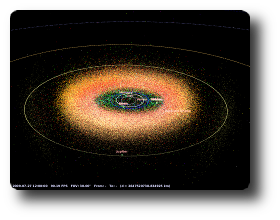- Skybot 3D -
The Solar System in 3D
Current version: Skybot3D v1.0 - 2018-05-01
Skybot3D service is currently in development, only part of the service is available.
 Presentation
Presentation

Skybot3D is an extension of
SkyBoT service. It is composed of a Web service and
a standalone software. It has been designed for whom wants to explore the Solar System in 3D, to learn the
structure of the small solar system objects, and to visualize the various population classes of asteroids
(NEA, Trojans, Centaurs, KBOs, ...), comets, planets and major natural satellites . It is also a usefull
service to query and retrieve at once the heliocentric state vectors or spherical coordinates of all solar
system objects, or a subset of them.
The high accuracy ephemeris provided by Skybot3D makes it perfect for scientists who are interested to get
quickly a snapshot of the solar system at a given epoch.
Skybot3D is the ideal tool for whom wants to create realistic animations such as a Solar system tour or the
encounter of a Near-Earth asteroid with the Earth.
Skybot3D is the essential software for the professors who want to make discover and explore the 3D structure
of the solar system to their students.
The Skybot3D Web service allows to retrieve a dataset of positions of Solar system objects, through
several methods:
- getAster
- This method extracts the positions of asteroids from the Skybot database,
for a reference epoch the closest from the requested epoch.
- getComet
- This method extracts the positions of comets from the Skybot database,
for a reference epoch the closest from the requested epoch.
- getPlanet
- This method computes the positions of planets and their major satellites, for a reference epoch the
closest from the requested epoch.
- getSso
- This method provides the positions of all the Solar system objects (asteroids, comets, planets and their
major natural satellites) for a reference epoch the closest from the requested epoch.
Administrative methods:
- getAvailability
- This method provides the availability of the Skybot3D web-service.
Check now!
 Practical use
Practical use
The Skybot3D service is an XML Web service that lives on the Web. You can access the published
methods to retrieve the state vectors of Solar system objects by making so called SOAP requests,
or by using VO applications such as
Aladin,
Topcat,... The underlying technology (XML+SOAP+WSDL)
being inherently interoperable, you can use them and implement them regardless of what your favourite
platform and operating system are. For that, you can
freely download toolkits
to help you to make the integration of the Skybot3D service seamless with your code.
The easiest way to execute Skybot3D is to use a non-interactive network downloader (e.g. curl, wget)
to send HTTP requests and to receive the data "on your desktop".
 Scientific issues
Scientific issues
The ephemerides provided by Skybot3D are heliocentric equatorial mean J2000 coordinates, expressed in
a rectangular (position and motion vector) or a spherical (right ascension, declination and distance)
format in the ICRF frame. The position and motion vectors of asteroids and comets are computed by numerical
integration of the 8 bodies pertubed problem, taking into account relativistic perturbations (post-newtonian
approximation). The source of the orbital elements of asteroids is the
Astorb
database, those of the comets is
CometPro. The ephemerides
of the planets are computed using the planetary theory
INPOP, and the
major natural satellites are computed using dedicated solution of their motion:
V. Lainey, V. Dehant and M. Pätzold 2007 for Mars,
V. Lainey, L. Duriez and A. Vienne 2004 for Jupiter,
A. Vienne and L. Duriez 1995 for Saturn,
J. Laskar and R.A. Jacobson 1987 for Uranus, and
C. Le Guyader 1993 for Neptune.
The ephemerides of the solar system objects, or a subset of them, can be retrieved in two manners:
- - by using the getAster or getComet or getPlanet
synchronous methods. These methods require very few computation and are rather fast. Each method allows to filter out
the classes of objects, and to retrieve a subset of them by limiting the number of objects to retrieve.
- - by using the getSso synchronous method to get all the solar system objects (provided by the previous
methods) in a single request, without filter out object classes, nor limit their number.
The synchronous methods getAster, getComet, getPlanet and getSso are freely available without restriction. The only limitation
of these methods is that the positions of objects are given for a specified epoch T
0 closed to the requested epoch
by less than 10 days (SkyBoT cut-off).
Once computed, the position of the objects in the solar system can be visualized and explored by using the free
Skybot3D software (
to be released soon).
To get the ephemerides of the solar system objects at a given epoch, you must use the previous methods in asynchronous mode.
This is recommended only for advanced users who need accurate positions of all solar system objects for their work.
See the asynchronous mode section for more information about this mode.
 Technical issues
Technical issues
The computation of accurate ephemerides of all the known solar system objects (more than 713,000 asteroids and 1,200 comets
on June 1, 2016) at a given epoch requires a numerical integration of their orbits. Even with parallel programming, this
work can take a while. That is why the synchronous methods of Skybot3D do not compute ephemerides. Instead, to respond to
requests as quickly as possible, it uses the pre-computed positions of the solar system objects available in SkyBoT database.
The cut-off of Sso positions in SkyBoT being 10 days, the positions returned by the synchronous methods are the positions
of the objects at a reference epoch (that of SkyBoT) close to, at most, 5 days of the requested epoch. The returned positions
are of course accurate at the reference epoch.
With about 710,000 asteroids known in the solar system, the amount of data sent back by Skybot3D.getAster method is substantial.
Encoded in XML (VOtable), the maximum volume of data to download is about ~215 Mbytes if uncompressed (-getFile=1) , and ~33 Mbytes
if compressed with Bzip (-getFile=0). In TEXT format, it is ~57 Mbytes if uncompressed (-getFile=1), and ~18 Mbytes bzipped (-getFile=0).
For ~1200 comets, the maximum volume of data to download is ~540 Kbytes if uncompressed (XML, -getFile=1), and ~70 Kbytes if bzipped,
while in TEXT format it is ~180 Kbytes uncompressed and ~40 Kbytes if bzipped. For JSON format, the volume of data to download is
~100 Mbytes for asteroids, and ~225 Kbytes for comets.
For the method getSso, the volume of data to download is ~33 Mbytes for VOtable format if bzipped (-getFile=0), ~233 Mbytes if
uncompressed (-getFile=1), and ~22 Mbytes for TEXT format (ZIP archive). If the JSON format is used, the volume of data to
download is ~100 Mbytes.
As a consequence, we strongly recommend to not request the Skybot3D getAster and getSso methods through an Internet browser
with the parameter getFile equal to 1 without filtering the classes or without limiting the number of objects. In addition
to the huge amount of data to download, the browser might be overloaded to format and display the data (XML, JSON, and even
the TEXT format).
 Asynchronous mode
Asynchronous mode
To be released soon
 Skybot3D software
Skybot3D software
Skybot3D is not only a Web service. It is also an opensource software written in C langage,
based on OpenGL, which can be used interactively to visualize and explore the solar system in 3-D.
To be released soon
 User support
User support
Each response sent back by the Skybot3D service contains a ticket number. This 12 digits number (e.g. 123003240449) identifies each request
and may be used to retrieve information on its processing. If you face with errors by using the Skybot3D service (it could occur that no relevant
error message is returned), please report us the ticket number corresponding to the problem. It will help us to anderstand and solve it, and
you will help us to improve the services.
The information regarding requests sent to Skybot3D is stored in a dedicated database. No personal information is stored, except the IP
address provided by the client, which is employed to make statistics on the geographical localization
of the Skybot3D users. The Skybot3D logs are never disseminated nor sent on request. You can access to the public logs by using the
following URL:
- http://vo.imcce.fr/webservices/skybot3d/showLog.php?ticket=[#ticket]&method=[method]
where:
- #ticket
- Ticket number of the request
- method
- Keyword defining the service: Skybot3d(getSso), Skybot3d(getAvailability)
If you are confronted with a bug, or if you would like to request improvements or special needs, please use the
IMCCE Mantis Bug Tracker (quick access: use the Report issue menu in the portal menubar).
 Notes to user
Notes to user
The numerical precision of the Skybot3D ephemerides differ from one target to another, mainly depending on the accuracy of the orbital elements.
As a consequence, you should not consider the accuracy of the computed positions as the number of digit which is provided. It is only a numerical
accuracy that is given to avoid truncation error.
In any case, the IMCCE cannot be held for person in charge for a misuse or interpretation of the Skybot3D service and the data that are provided.
 How to cite Skybot3D
How to cite Skybot3D
If Skybot3D was helpful for your research work, the following acknowledgment would be appreciated:
"This research has made use of IMCCE's Skybot3D VO tool". Skybot3D being based on
SkyBoT
service, you can also cite the following article
2006ASPC..351..367B.
- Bibitem:
-
\bibitem[Berthier et al.(2006)]{2006ASPC..351..367B} Berthier, J., Vachier, F., Thuillot, W., Fernique, P.,
Ochsenbein, F., Genova, F., Lainey, V., \& Arlot, J.-E.\ 2006, Astronomical Data Analysis Software and
Systems XV, 351, 367
- Bibtex code:
-
@INPROCEEDINGS{2006ASPC..351..367B,
author = {{Berthier}, J. and {Vachier}, F. and {Thuillot}, W. and {Fernique}, P. and
{Ochsenbein}, F. and {Genova}, F. and {Lainey}, V. and {Arlot}, J.-E.},
title = "{SkyBoT, a new VO service to identify Solar System objects}",
booktitle = {Astronomical Data Analysis Software and Systems XV},
year = 2006,
series = {Astronomical Society of the Pacific Conference Series},
volume = 351,
editor = {{Gabriel}, C. and {Arviset}, C. and {Ponz}, D. and {Enrique}, S.},
month = jul,
pages = {367-+},
adsurl = {http://adsabs.harvard.edu/abs/2006ASPC..351..367B},
adsnote = {Provided by the SAO/NASA Astrophysics Data System}
}


 Presentation
Presentation Skybot3D is an extension of SkyBoT service. It is composed of a Web service and
a standalone software. It has been designed for whom wants to explore the Solar System in 3D, to learn the
structure of the small solar system objects, and to visualize the various population classes of asteroids
(NEA, Trojans, Centaurs, KBOs, ...), comets, planets and major natural satellites . It is also a usefull
service to query and retrieve at once the heliocentric state vectors or spherical coordinates of all solar
system objects, or a subset of them.
Skybot3D is an extension of SkyBoT service. It is composed of a Web service and
a standalone software. It has been designed for whom wants to explore the Solar System in 3D, to learn the
structure of the small solar system objects, and to visualize the various population classes of asteroids
(NEA, Trojans, Centaurs, KBOs, ...), comets, planets and major natural satellites . It is also a usefull
service to query and retrieve at once the heliocentric state vectors or spherical coordinates of all solar
system objects, or a subset of them.
 Practical use
Practical use Scientific issues
Scientific issues Technical issues
Technical issues Asynchronous mode
Asynchronous mode Skybot3D software
Skybot3D software User support
User support Notes to user
Notes to user How to cite Skybot3D
How to cite Skybot3D